The 15 Best Reciprocating Saw in 2023 – You should search for the best reciprocating saw available on the market when it comes to projects at home or demolition work. These saws provide a great deal of precision cutting, among many other features.
There is no need for you to worry about finding the information you need about cutting tools when you are at Linquip. The purpose of Linquip is to provide you with a wide selection of the best reciprocating saws on the market so that you can do your work more efficiently. For a basic understanding of what Linquip offers with regards to saws, you can visit Linquip “What Is Saws?” page.
Would you like to purchase a saw for your use? Linquip’s website has an extensive database of Saws Products that you can search through for free and find the products that you want to buy. If you are looking for the most affordable price on reciprocating saws equipment and devices, then you are in the right place. It is very easy to send a request to a variety of Saws Suppliers and Companies using Linquip, and you will be able to receive free quotes from them in a short period of time.
Hand-held reciprocating saws are commonly used for demolition work. Several materials can be cut with reciprocating saws, including wood and metal.
In addition to knowing what type of material will be cut, you can determine the best and the most high-quality reciprocating saw for the job based on how often you will use the reciprocating saw. Find out what you should consider when buying a reciprocating saw and why these models are the best for different demolition projects.
How We Selected The 15 Best Reciprocating Saw in 2023
At Linquip, we are committed to providing you with the most reliable and up-to-date information on the best tools and equipment for your home and professional projects. That’s why we have spent hours researching and analyzing more than 10 webpages and hundreds of products and reviewers to find the 15 best reciprocating saws in 2023. We have also consulted with our experts who have years of experience in using and testing reciprocating saws for various applications and materials. We have considered factors such as power, performance, durability, features, design, comfort, safety, and value for money to rank and review each product. We have also included pros and cons, specifications, and general descriptions for each saw to help you make an informed decision. Whether you need a reciprocating saw for demolition, remodeling, plumbing, or landscaping, we have got you covered with our comprehensive and unbiased guide.
Basics of Reciprocating Saw
Reciprocal saws are handheld electric machines with blades that have a cutting motion backward and forward. As a result of its ability to cut through wood, metal, drywall, piping, and nails, this handy tool makes demolition work easier.
There are many applications for reciprocating saws in the construction industry. They can cut most materials on the Jobsite, including wood, plastic, epoxy, metal, concrete, etc. Due to its versatility, it is used mostly for construction and demolition work because it can cut a wide range of building materials if the right blade is installed.
As the cutting blade travels quickly back and forth, it produces cutting action. A reciprocating saw blade can be anywhere from 3 inches to 13 inches in length, and the saw itself can be any length or size.
Due to their stiffness and aggressiveness, shorter blades make straighter cuts, such as when cutting metal or materials that are harder.
Blades that are longer have more flexibility, so they can bend flush with the material, making flush cuts easier. Ideally, they’re used for pruning, demolitions, and auto dismantling, among other things. Having a larger surface area allows them to dissipate more heat.
Reciprocal saws vary in power depending on the type of blade and the amount of amps they have. A higher amp rating translates into more power and aggressiveness during cutting.
Below you’ll find a guide that helps you buy the suitable reciprocating saw for your project, considering the type of performance you need, the construction quality, the ergonomics, and the portability.

Reciprocating Saw Buying Guide
If it’s your first time buying a reciprocating saw, there are several factors you need to consider before making a choice. Power, features, and reliability should all be taken into consideration when evaluating reciprocating saws. For the best decision, read through carefully.
Corded or Cordless Reciprocating Saw
The first decision you have to make when purchasing your first reciprocating saw is whether you want a corded or cordless model. A corded one is one that uses an extension cord to connect to a power source, while a cordless one relies on batteries.
You will have to decide which one to choose based on the type of work you need to do, the location, and the duration. However, the latter two will have a significant impact.
Work can be done anywhere with a cordless reciprocating saw. Whenever you cannot access a power outlet, it’s the best option. A cordless unit is the best option for pruning trees in the garden or even on a remote job site without electricity.
Most people usually associate cordless tools with less power and shorter run times because they have limited battery life. Technological advancements have allowed for more competitive pricing in cordless tools in the last few years.
A brushless motor, for example, is more energy-efficient than a traditional motor. Additionally, innovations in batteries have revolutionized how batteries are integrated with tools, allowing cordless tools to run longer.
Therefore, if your work takes you to places without electricity, don’t be afraid to invest in a cordless tool. If you have constant access to electricity, however, then a corded reciprocating saw is the best option, and it is not necessary to purchase a cordless one.
Power
There are different amp ratings on cordless reciprocating saws that you’ll come across when shopping for one. A higher amp means tougher work. Therefore, you can expect to see 7.5 amps, 9, 10, 11, 12, 13, and 15 amps.
In the case of cordless reciprocating saws, the voltage rating will be displayed. Among the tools, you will find 18 Volts and 20 Volts Max. In terms of battery-operated tools, 20 Volts does not necessarily mean more power than 18 Volts. In fact, they are the same.
20 Volt cordless tools are labeled as 20 Volt Max when you check them. In other words, 20 volts refers to the voltage of the battery when fully charged.
Once the tool starts to discharge, its voltage will likely drop to 18 volts, its nominal voltage, making it the same as all other 18 volt tools.
In other words, regardless of whether a cordless reciprocating saw is labeled 18 volts or 20 volts max, If all other factors are considered, you can buy any cordless reciprocating saw.
Variable Speed
With reciprocating saws that have variable-speed triggers, you can vary the saw’s speed or strokes per minute (SPM) by adjusting how far back you pull the trigger. Other saws come with a variable speed dial that allows you to change the speed simply by a turn of the dial.
It is essential to have this capability because sometimes, in order for the blade to cut effectively, it is necessary to vary the speed.
The speed at which a material can be cut through effectively varies for different materials. Metal, for example, is denser and stronger, so you should cut at a slower speed. Therefore, going full throttle may damage the blade. The speed may be gradually increased as the cut progresses. However, if you want to effectively cut through wood, you have to go fast.
Therefore, you should choose a reciprocating saw that can be adjusted according to your work when choosing one.
Blade Change
When working on your project, you will need to change your blades. Your reciprocating saw blade may need to be replaced if it becomes dull or if you plan to cut another material that has a different type.
To reduce downtime, it is important that you can swap the blades of your reciprocating saw quickly and easily.
The majority of units feature a tool-less blade change mechanism, consisting of a simple lever that you can pull up with your finger to change the blade. Put another blade in place and push it down firmly to secure it.
Therefore, you should choose one with this feature. It is never a good idea to buy a reciprocating saw that needs a tool to change the blade.
If you’re using a cordless reciprocating saw, you should always unplug it or remove the battery before changing the blade. It is always important to take safety actions when using power tools.
Size
When you’re working under a car or in between studs, you’ll be able to use smaller units that fit into tight spaces. Moreover, if all you need to do is prune trees in your garden, you may not really need large reciprocating saws. You might just need a compact one.
Due to their compact size, plumbers will also find these useful for cutting pipes, as they can fit into tight spaces. Not only are these compact models small, but they are also lightweight.
Vibration Control
A reciprocating saw operates by moving the blade back and forth. As soon as you switch it on, the mechanism inside causes a lot of vibration from inside. Therefore, some manufacturers provide vibration stabilizers to assist in reducing vibration.
In reciprocating saws, vibration control is not a necessary feature, and anti-vibration controls will not eliminate all vibrations. It’s still important that the saws have vibration control, which makes operating them a little more comfortable.
Speed and Length of Strokes
Two factors directly affect the speed at which the reciprocating saw cuts through a material: strokes per minute and stroke length. It is not the length of the blade that defines a stroke, but how far the saw advances or retracts the blade following a push forward.
If all other factors are equal, a reciprocating saw with a longer stroke length will cut faster.
Generally, reciprocating saws have stroke lengths ranging from 1-1/4 to 1-1/8, but 1-1/8 is the most common.
Among compact units, you may find some that have stroke lengths as high as 1-1/8, while other compact units may have lower stroke lengths.
The stroke speed usually ranges between 2700 and 3000 strokes per minute (SPM). It’s okay if the stroke speed is 2900 and above.
In conclusion, the speed at which a reciprocating saw cuts a material depends on both the stroke length and the stroke speed.
Battery
What kind of battery you use to power a cordless reciprocating saw will determine how long it lasts.
Ergonomics
It is also important to take into account the overall design of a reciprocating saw. If you make the purchase online, you may not have the chance to hold it before purchase. However, if you buy it from a local hardware store, you should definitely keep it and feel how it feels.
You will feel more comfortable holding one with a rubberized handle. When shopping online, look for features such as those.
Orbital Action
Some reciprocating saws do not offer orbital action. This feature is designed for cutting through wood layers, adding an elliptical motion on top of the reciprocating saw’s back and forth motion. When you need to cut through wood quickly, choose a reciprocating saw with orbital action.
Best Reciprocating Saw Reviews
Below are some reciprocating saws that feature a variety of the above key factors, and they are all top-rated for power, speed, and reliability. It is possible that one of these reciprocating saws will be the best choice for you.
9 Best Reciprocating Saw include:
- Milwaukee 2720-21 M18 Fuel Sawzall Reciprocating Saw Kit
- AEG BUS18-0 Cordless Reciprocating Saw
- Bosch RS428
- BLACK+DECKER 20V MAX Cordless Reciprocating Saw
- Porter Cable PCC670B Tigersaw0
- Ryobi P514
- Makita 18V LXT Reciprocating Saw
- DEWALT DCS369B 20V MAX One-Handed Reciprocating Saw
- Skil PWRCore RS582902
1. Milwaukee 2720-21 M18 Fuel Sawzall Reciprocating Saw Kit
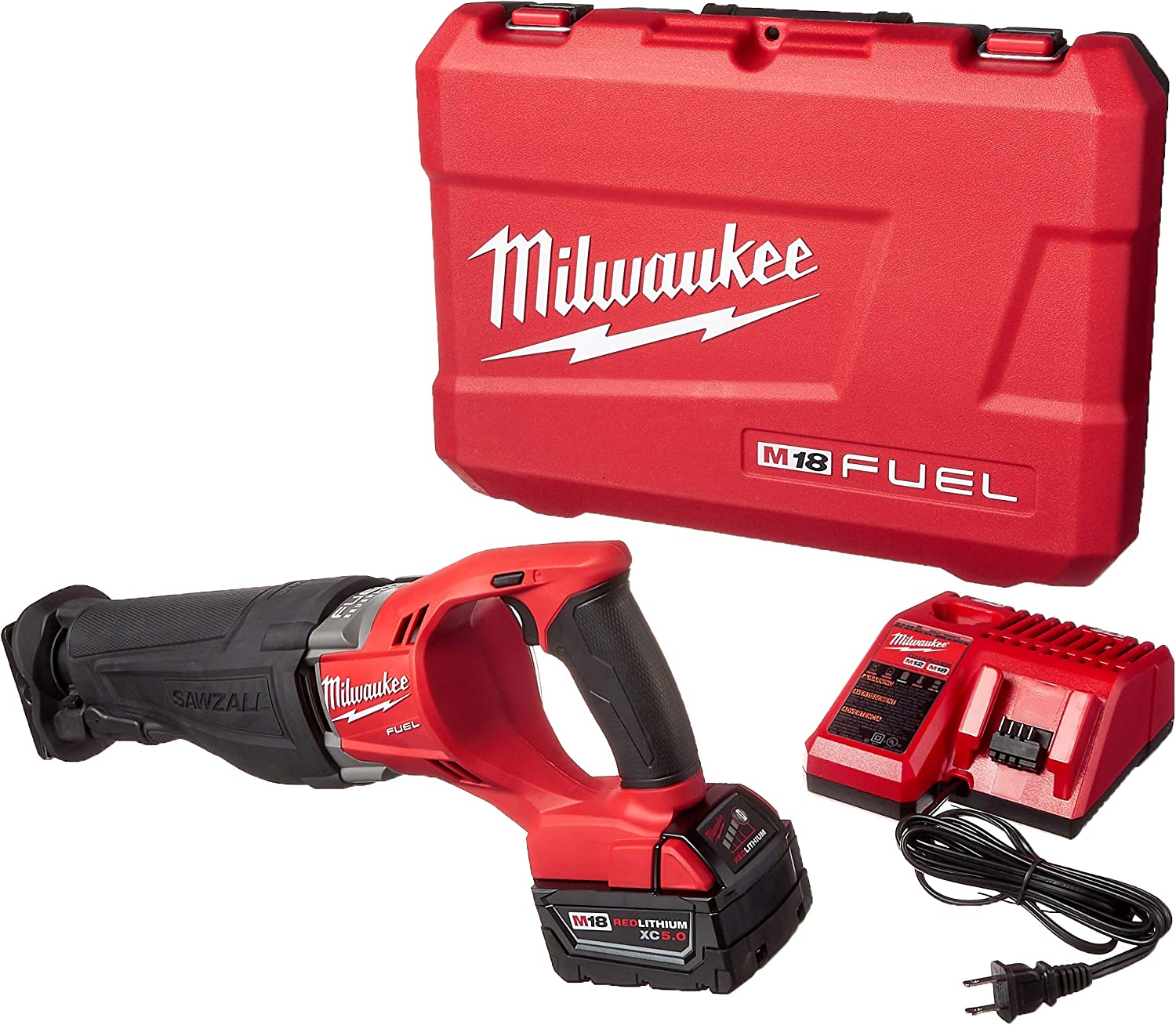
Specifications
| Weight | 11.4 pounds |
| Dimensions | 15 x 20 x 21 inches |
| Number of teeth | 24 |
| Power source | Battery powered |
| Color | Red |
| Material | Metal |
Product Description
Among power tools, the Milwaukee 2720-21 M18 Fuel Sawzall stands out. It is equipped with a cordless reciprocating saw, a battery, a charger, reciprocating saw blades, as well as an instruction manual, and a stud hanger. It is imperative to have this feature if you have ever climbed a ladder to set down a Sawzall.
It is really comfortable to hold since it has a rubberized pistol grip on the back and a second-hand grip on the front. This saw surpasses every other saw in terms of the number of cuts made and also has an excellent performance in the number of cuts per amp-hour (AH) of battery capacity.
Due to the superior battery and the superior cutting, this saw works exceptionally well.
There are some downsides, including the plastic levers that control the blade-changing mechanism and the depth guard. It’s unclear how long these pieces will last. It was also challenging to clean the saw since it spat sawdust for days. Additionally, it was tough on blades—after the third cut, the user may need to swap to a new blade.
The Milwaukee Fuel Sawzall is an expensive saw. Its price is offset by the fact that this saw comes with a charger, battery, and hard case, as well as its brushless motor, which is more powerful, efficient, and longer lasting than typical brushed motors.
It is hard to find a better reciprocating saw if you intend to use it for something even remotely strenuous.
2. AEG BUS18-0 Cordless Reciprocating Saw
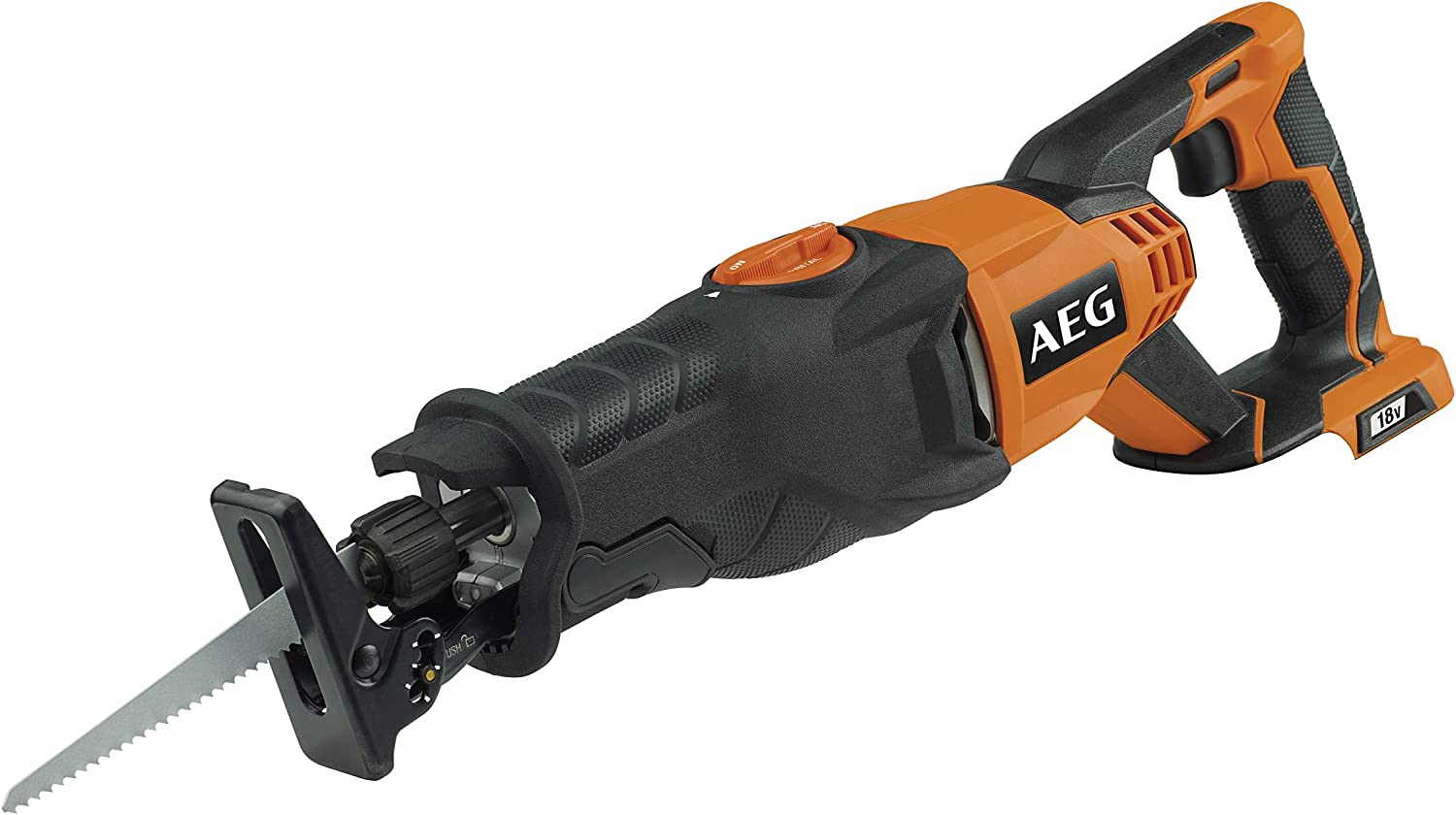
Specifications
| Weight | 7.45 pounds |
| Dimensions | 5.9 x 6.3 x 18.9 inches |
| Voltage | 18 |
| Power source | Hand-operated |
Product Description
This AEG BUS18 reciprocating saw is a very powerful reciprocating saw with a lot of features and a weight that is easy to control while cutting. This reciprocating saw comes in handy for demolition work. Even substantial joists for the patio are no problem for it, as it chews through everything. Due to its pendulum function, it also works extremely fast. With this reciprocating saw, you can also cut up bushes and chunky branches from trees with ease.
This saw’s weight also makes it easier for you to maintain good control of the cutting process and be ready when the branches start to fall. Weight is only a disadvantage when it comes to working at heights with the BUS18. Holding the saw becomes difficult as soon as your arms are higher than your hips. It would have been helpful to have an extra handle. Using a reciprocating saw, however, should be done with caution, and using a ladder is a good idea if you need to work at height.
The battery life is excellent. Moreover, the batteries recharge quickly. It is easy to switch directly from the charging station when the first battery runs out, as the other one has already been charged. Additionally, the rubber grip is comfortable, and the blade can be rotated 180 degrees. The blade can be adjusted for depth and angle easily.
You don’t need any tools to replace the saw blade. This reciprocating saw lacks a significant feature, which is the possibility to steplessly lock the angle of the baseplate. Although it can be locked into three positions, the current solution is a bit fiddly and stiff. To ensure we were on the right side of the material, we would have liked clear markers on the baseplate.
The AEG BUS18 is an absolutely excellent value for the price, all the advantages mentioned above, and the fact that it works on batteries with the freedom that implies. The battery can also be shared with other AEG tools you already own.
3. Bosch RS428

Specifications
| Weight | 3.4 pounds |
| Dimensions | 18.4 x 4 x 6.3 inches |
| Voltage | 120 |
| Color | Blue |
| Power source | Battery-operated |
Product Description
It is sometimes necessary to cut through more than a few 2x4s in order to accomplish your goal. In the event that a battery-powered reciprocating saw isn’t cutting it, you might want to consider a corded reciprocating saw. This Bosch RS428 14 Amp Corded tool is corded and delivers on all counts.
Any item you put in front of this beast of a saw will be destroyed with ease. Precision cutting is made possible by the tight turning radius and the ability to turn on a dime.
Even after prolonged use, the Bosch RS428 remains comfortable to hold. The vibration control on this saw is excellent. Moreover, the variable speed trigger is locked to keep the saw running. As demolition jobs can last for a long time, the trigger lock feature is great, but sometimes it would be horrifying if you lost control of the demolition machine if you had the lock on.
Although there are some strengths, there are a few weaknesses as well. The depth guard on the Bosch RS428 is tricky to move, and the blade receptacle is hard to access. In order to replace the blade, turn the black lock until the blade is released and hold it open while inserting the new one. In many other saws, changing the blade is easier.
It also takes a second for the Bosch RS428 to rev up to speed – the delay isn’t long, but it is noticeable. Almost anything can be sliced through quickly once it gets going.
4. BLACK+DECKER 20V MAX Cordless Reciprocating Saw
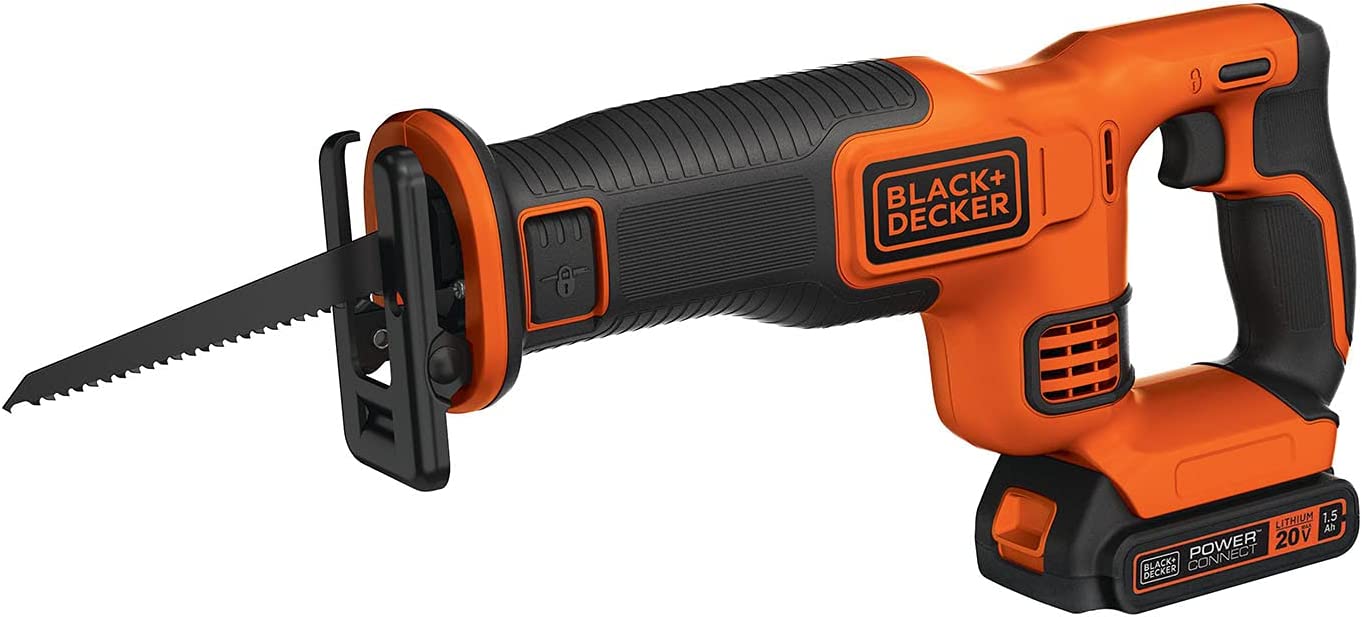
Specifications
| Weight | 4.5 pounds |
| Dimensions | 15 x 3 x 7 inches |
| Number of teeth | 24 |
| Color | Black |
| Power source | Battery-operated |
| Voltage | 20 volts |
Product Description
BLACK+DECKER’s 20V MAX Cordless Reciprocating Saw is powerful and reliable for making precise cuts. In addition to having a reciprocating blade, this cordless option also features a pivoting shoe for increased control. In order to avoid unnecessary cutting, a safety brake and tool-free blade change feature ensure added safety.
It weighs only 4.5 pounds, is compact and lightweight, and has a variable speed trigger that delivers over 3,000 SPM. You will also receive a 20V lithium-ion battery and a charger.
5. Porter Cable PCC670B Tigersaw

Specifications
| Weight | 3.75 pounds |
| Dimensions | 16.19 x 3.5 x 7.63 inches |
| Number of teeth | 24 |
| Voltage | 20 volts |
| Power source | Battery-powered |
Product Description
A reciprocating saw can perform tasks that no other tool can. A reciprocating saw might be overpriced for an average homeowner since the average person doesn’t need one very often and might only use it once or twice a year. We recommend the Porter Cable 20V Max Variable Speed Reciprocating Saw as our budget-friendly pick of the bunch because it has all the features occasional-user homeowners might need in a reciprocating saw.
This Porter Cable 20V Max is easy to handle With one hand, light, and portable. Although it cut more slowly than some of the higher-end saws, it cut smoothly and cleanly and had a tighter turning radius than most others. On a demolition tool, bells and whistles aren’t frequently needed, so it lacks bells and whistles.
The battery life of this device is one of its most impressive features.
This little saw is an excellent choice for budget-conscious, occasional-use homeowners due to its price, performance, and battery capacity.
6. Ryobi P514
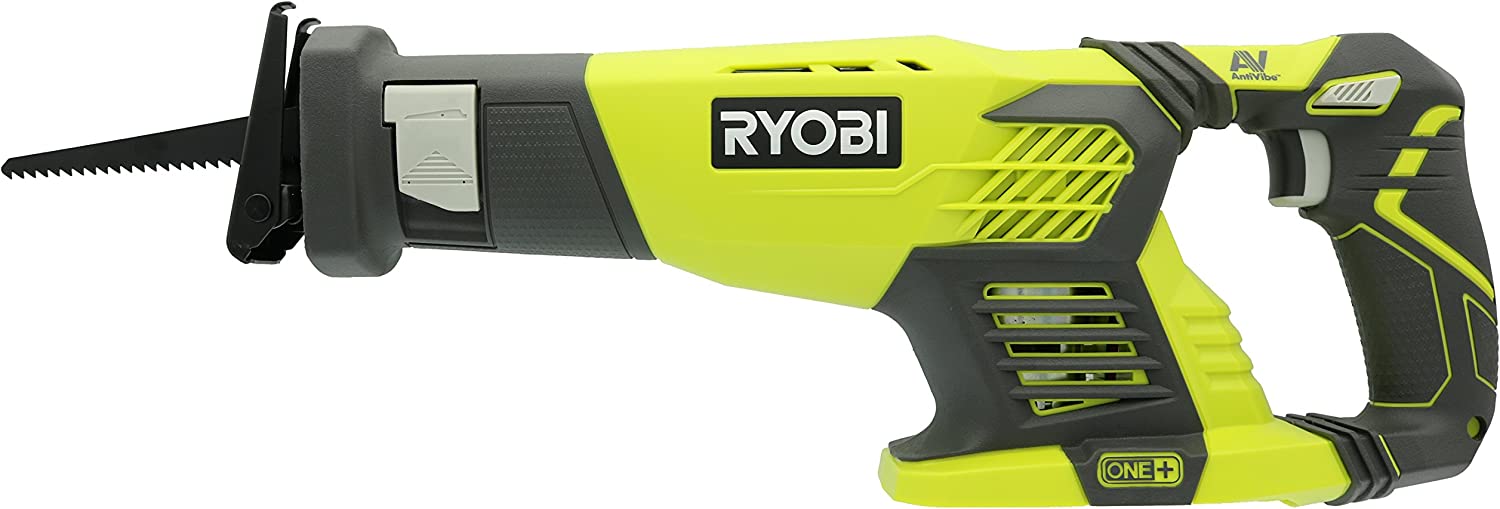
Specifications
| Weight | 4 pounds |
| Dimensions | 17 x 7 x 4 inches |
| Number of teeth | 18 |
| Color | Green/Black |
| Power source | Battery-powered |
Product Description
Besides its straight mode in which the blade moves in and out, this saw also has an orbital mode, where the blade moves in a circular motion. A nice feature of the integrated light is that it allows you to cut easily in low-light conditions.
Among the bunch of saws, it also has the best blade change mechanism. Upon opening the level to remove the blade, it locks open until it is closed. In addition, the batteries are easy to replace.
You may slip your hand off the top of the saw during long cutting sessions due to the lack of dip in the grip near the trigger. Furthermore, it is unable to turn for the sake of its life.
There is no doubt that this is a nice saw, but its durability and grip make it more challenging to operate than you might like.
7. Makita 18V LXT Reciprocating Saw
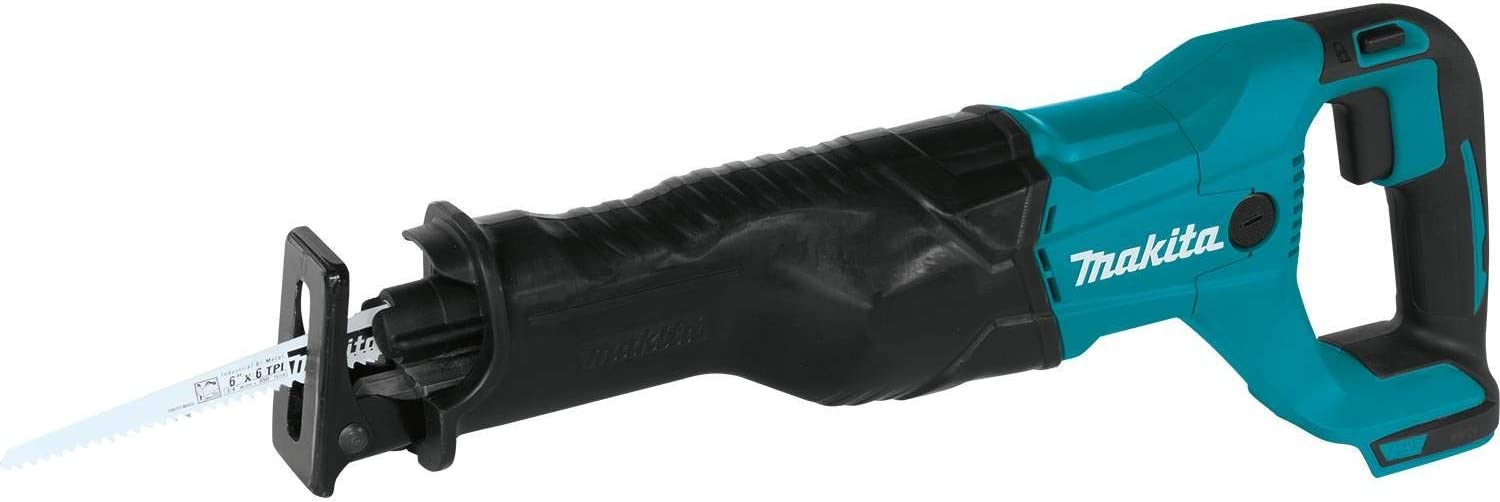
Specifications
| Weight | 8 pounds |
| Dimensions | 4.69 x 20.5 x 8.62 inches |
| Blade Length | 4 inches |
| Voltage | 18 volts |
| Power source | Battery-powered |
Product Description
This cordless reciprocating saw from Makita combines power, ergonomics, and dependability to make an excellent choice. Two-handed Makita reciprocating saws are made by a manufacturer known for producing quality power tools for the construction industry. This saw features an ergonomic grip and variable speed trigger that reduces hand fatigue.
An 18-volt lithium-ion battery powers the saw (battery and charger are sold separately) and offers a maximum speed of 2,800 strokes per minute. This saw weighs 8.3 pounds and measures 19-1/8 inches in length. Batteries for the Makita cordless power tools are interchangeable with the ones used for the saw. The downside is that you are not provided with blades as part of your purchase.
8. DEWALT DCS369B 20V MAX One-Handed Reciprocating Saw
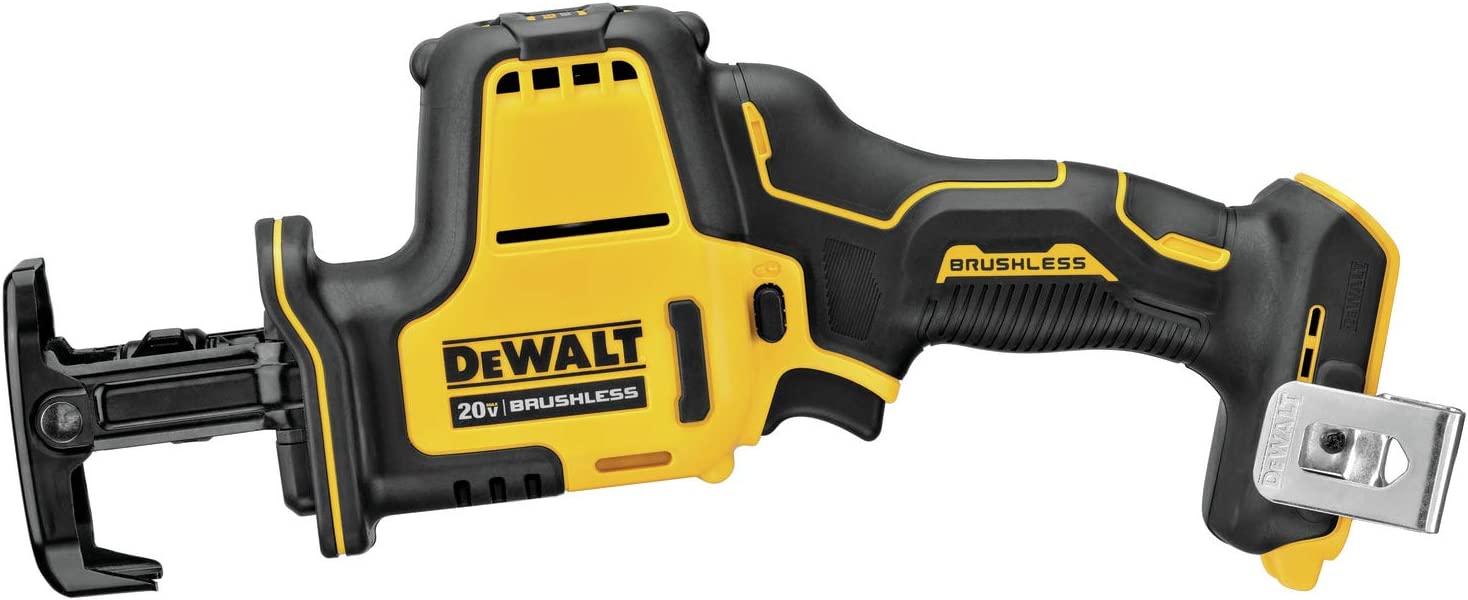
Specifications
| Weight | 3.74 pounds |
| Speed | 2800 SPM |
| Number of teeth | 24 |
| Voltage | 20 volts |
| Power source | Air-powered |
Product Description
Featuring just 12.5 inches of length and 3.74 pounds of weight, the DEWALT 20V MAX One-Handed Reciprocating Saw can be used to saw in tight spots. Designed for use in small areas, where a full-size saw would be too large and bulky, this one-handed saw has a blade “shoe” to assist with stabilizing the saw as it cuts.
With its variable speed trigger and bright LED light, this compact reciprocating saw is capable of accurate cutting even in low light. In addition to the two wood blades that come with this DEWALT saw, it also comes with an optional belt hook to help you hang it on your tool belt. Neither the battery nor battery charger is included with the device. The battery ensures operation and is rechargeable at 20 volts.
9. Skil PWRCore RS582902
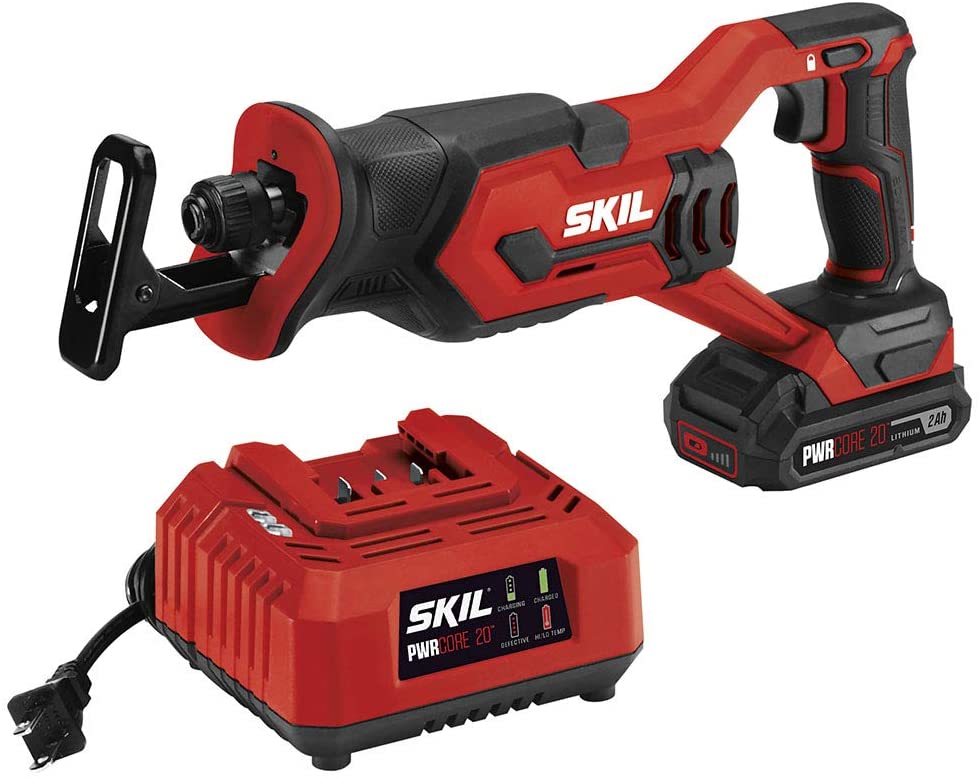
Specifications
| Weight | 3.74 pounds |
| Speed | 2800 SPM |
| Number of teeth | 24 |
| Voltage | 20 volts |
| Power source | Air-powered |
Product Description
Another good but not great saw is the Skil Pwrcore RS582902. All of your tests are completed within reasonable time frames, though not in the best possible way. There are no hiccups or complaints with any of them, and it is easy to use.
As far as performance is concerned, the Skil performs best on plywood obstacle courses, where it has the tightest turning radius and finishes in a decent time. In addition to being lightweight and easy to use, it is also comfortable to use for a prolonged period of time.
However, it doesn’t come with a lot of extra features to compensate for its unimpressive performance. The blade depth is changeable with the use of a hex key.
The hex key is provided by Skil; however, the storage slot fitted into the saw for it is not tight enough to prevent it from falling out. You’re probably going to lose the key due to vibrations out of place.
10. Makita 11 Amp JR3050T Reciprocating Saw

Specifications
| Power Source | Corded Electric |
| Voltage | 120 Volts |
| Amperage | 11 Amps |
| No Load Speed | 20 0 – 2800 SPM |
| Stroke Length | 1-1/8 Inches |
Product Description
The Makita 11 Amp JR3050T Reciprocating Saw is a handheld electric saw with a blade that moves in a backward/forward cutting motion. It can cut through wood, metal, drywall, plastic, and other materials with ease. It has a variable speed trigger that allows users to adjust the cutting speed according to the material and application. It also has a tool-less blade change system that enables users to quickly and easily switch blades without using any tools. The saw has a protective rubber boot that covers the motor and bearings to prevent dust and debris from entering and damaging them. The saw also has a built-in dust blower that clears the line of cut for better visibility and accuracy. The saw has a well-balanced design that weighs only 7.3 lbs, making it comfortable to use for long periods of time. The saw has a long 1-1/8 inch stroke length that enables it to cut faster than shorter stroke saws. The saw is corded, which means it requires an electrical outlet and an extension cord for power. The saw does not have orbital action, which means it does not move the blade in an elliptical pattern to increase its cutting efficiency in wood materials. The saw does not come with a battery, charger, or carrying case, which means users need to purchase them separately if needed.
11. Ingersoll Rand 429 Air Reciprocating Saw

Specifications
| Power Source | Air-Powered |
| Air Pressure | 90 PSI |
| No Load Speed | 10,000 SPM |
| Stroke Length | 3/8 Inches |
| Length | 8.25 Inches |
Product Description
12. DEWALT DCS367B XR Reciprocating Saw

Specifications
| Power Source | Battery Powered |
| Voltage | 20 Volts |
| Battery Type | Lithium Ion |
| No Load Speed | 0 – 2900 SPM |
| Stroke Length | 1-1/8 Inches |
Product Description
13. Metabo HPT MultiVolt Variable Speed Cordless Reciprocating Saw

Specifications
| Power Source | Battery Powered |
| Voltage | 36V or 18V |
| Battery Type | Lithium Ion |
| No Load Speed | 0 – 3000 SPM |
| Stroke Length | 1-1/4 Inches |
Product Description
14. Worx Power Share Axis Cordless Reciprocating & Jigsaw

Specifications
| Voltage | 20V Max |
| Stroke length | 3/4 in. |
| No-load speed | 3000 spm |
| Blade type | Reciprocating saw blade, T-shank jig saw blade |
| Blade change | Tool-free |
Product Description
The Worx Power Share Axis Cordless Reciprocating & Jigsaw is a versatile and convenient tool that can handle various cutting tasks with ease. It has a pivoting head that converts from a reciprocating saw to a jigsaw in seconds with a push-button. It has orbital cutting technology that provides a more efficient cut for different materials such as wood, metal, plastic, ceramic tile and tree limbs. It also has a built-in blower that removes dust and debris to increase cutting visibility. It is powered by a 20V Max Lithium battery that is compatible with other Worx Power Share tools. It has a tool-free blade change system that accepts standard reciprocating saw blades and T-shank jig saw blades. It is lightweight and compact for easy maneuverability and reduced fatigue.
15. Makita JR3051T Reciprocating Saw

Specifications
| Voltage | 120V |
| Amperage | 12A |
| Stroke length | 1-1/4 in. |
| No-load speed | 0-2800 spm |
| Blade type | Reciprocating saw blade |
Product Description
The Makita JR3051T Reciprocating Saw is a powerful and versatile tool that can handle various cutting tasks with ease and speed. It has a 12-amp motor that delivers fast and smooth cutting performance for different materials such as wood, metal, plastic, drywall, and plaster. It has a tool-less blade change system that allows quick and easy blade replacement. It has a variable speed trigger that enables precise control of the cutting speed. It has a long 1-1/4 inch stroke length that increases cutting efficiency and versatility. It also has a built-in dust blower that clears the cutting path for better visibility. It has a large two-finger trigger that allows easy operation even with gloves on. It has a rubberized boot that protects the motor and bearings from dust and debris. It has a soft grip handle that reduces vibration and fatigue. It is lightweight and compact for easy maneuverability and reduced fatigue.
Download the Best Reciprocating Saw in 2023 PDF
The article is available in PDF format if that is more convenient for you. In order to download the file, click on the link below.
Buy Equipment or Ask for a Service
By using Linquip RFQ Service, you can expect to receive quotations from various suppliers across multiple industries and regions.
Click Here to Request a Quotation From Suppliers and Service Provider
Read More In Linquip
- 10 Types of CNC Machine + Applications & Pdf
- 10 Types of Circular Saws + Characteristics & Usages
- What Is CNC Machining & How Does It Work? (A Comprehensive Guide)
- 19 Types of Saws + Characteristic & Usage
- Difference Between 2 Stroke and 4 Stroke
- 4 Types of Thermowell: Application and Duty
- All Types of Pneumatic Fittings: Specifications and Applications
- 5 Types of Proximity Sensors (Application and Advantages)
- Types of Humidity Sensors: A Full Explanation on The Most Common Types



